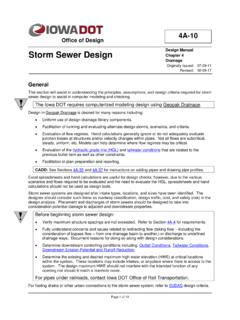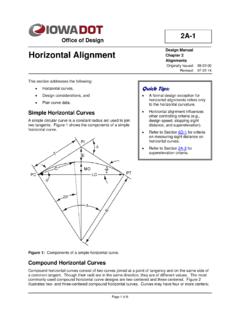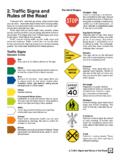Transcription of Design Manual Engineering Properties of Soil and Rock
1 Page 1 of 12 This section provides guidance on selecting soil and rock Engineering Properties for use in geotechnical Design . Properties selected for Design should be based on the results of field testing, laboratory testing, or back analysis of existing conditions. In addition, local experience, correlations to local geologic formations, and relevant published data should also be considered in the final selection of Design parameters. The geotechnical designer should assess the variability of the Engineering Properties to determine if the observed variability is a result of laboratory testing variability or subsurface variations across the site. The geotechnical designer is responsible for selecting the geotechnical Engineering Properties that are appropriate for the analyses required for Design of the project. Geotechnical Design parameters should be established for each of the geologic strata identified at a project site.
2 A geologic stratum, consisting of either soil or rock material, is characterized as having the same geologic depositional history and stress history, and generally has similarities throughout the stratum in terms of density , source material, etc. Soil Strata Soil is a nonhomogeneous, porous material for which Engineering behavior is greatly influenced by density , source material, stress history, and hydrogeology. Some Engineering Properties ( , undrained shear strength in normally consolidated clays) may vary as a predictable function of a stratum dimension ( , depth below the top of the stratum). Where the Engineering property varies within a soil stratum, the engineer should develop the Design parameters taking this variation into account. This may result in multiple values within the stratum. Rock Strata determination of Design parameters for rock should take into consideration the in-situ rock Properties (condition of the rock mass), which are generally controlled by the discontinuities within the rock mass and not the Properties of the intact material.
3 A combination of laboratory testing on small samples, empirical analysis, field observations, and Engineering judgment should be employed to determine the Engineering Properties of rock masses, with appropriate emphasis placed on visual observations and quantitative descriptions of the rock mass. Influence of Existing and Future Conditions on Soil and Rock Properties Soil Properties are not intrinsic to the soil type, but vary with the influence of stress, groundwater, and other environmental conditions. Thus, it is important to determine the existing conditions, as well as how conditions may change over the life of the project. For example, construction of a new embankment places new surcharge loads on the underlying soil profile. As the stress increases due to loading, the Engineering Properties of the underlying soil strata may also change. For example, normally consolidated Engineering Properties of Soil and Rock 200E-1 Design Manual Chapter 200 Geotechnical Design Originally Issued: 01-15-14 Revised: 05-1 9-1 5 Quick Tips: The geotechnical designer is responsible for determination of geotechnical parameters.
4 Selection of soil/rock Engineering Properties requires that the designer understand the loading conditions and soil/rock behavior. Office of Design Chapter 200 Geotechnical Design Section 200E-1 Engineering Properties of Soil and Rock Page 2 of 12 clays can gain strength with increases in effective stress. On the other hand, over-consolidated clays or weak rock may lose strength with time when exposed in cuts. The geotechnical engineer is responsible for choosing Design parameters representative of existing and future conditions. determination of Soil and Rock Properties Subsurface soil or rock Properties are generally determined using empirical correlations related to the testing that is performed during the field exploration program ( Standard Penetration Test (SPT)) outlined in Section 200C-1 and/or the laboratory testing as outlined in Section 200D-1. The laboratory testing program generally consists of index tests (classification) to obtain general information or to use with correlations to estimate Design Properties , and performance tests (strength and compressibility) to directly measure specific Engineering Properties .
5 The observational method or back analysis can be used to determine Engineering Properties of soil or rock in cases where slope failures occur, or where embankment settlement or excessive settlement of existing structures have been observed. For instance, with landslides or slope failures, the geotechnical engineer determines the geometry of the failure and then selects the soil/rock parameters, aided by correlations with index tests (if available) or experience, that result in a factor of safety approaching For embankment or structure settlement, the Engineering Properties of the soils can sometimes be determined from laboratory tests outside and inside the zone of stress influence resulting from the loading, and then correlating these Properties for the magnitude of the known loads. As with slope stability analysis, the pre-existing and final geometry of the subsurface soil must be adequately known, including the history of the groundwater levels.
6 For the detailed measurement and interpretation of soil and rock Properties , follow the guidelines provided in Section 200D-1 and FHWA-IF-02-034, Evaluation of Soil and Rock Properties , Geotechnical Engineering Circular No. 5 (Sabatini, et al., 2002), except as specifically indicated herein. Engineering Properties of Soil The selection of soil Properties for Design and analysis by the geotechnical engineer requires that the designer has a good understanding of the loading conditions and the soil behavior, has high quality soil sampling and testing, and has local geotechnical experience with the various geologic formations. This section provides guidance in the selection of Engineering Properties for cohesive soils (clays and highly plastic silts) and cohesionless soils (sands and non-plastic silts) for use in geotechnical Design . Unit Weight The total (wet) unit weight of soils, see Table 1, can be estimated from typical values, or measurements of mass and volume can be performed on Shelby tube samples or California or Modified California rings.
7 Moisture content can provide the necessary data for calculating the dry unit weight of the materials. Chapter 200 Geotechnical Design Section 200E-1 Engineering Properties of Soil and Rock Page 3 of 12 Table 1: Typical unit weight values for soils in their natural state (after Peck, Hanson, and Thornburn, 1974). soil description dry unit weight (pcf) wet unit weight (pcf) uniform sand (loose) 90 118 uniform sand (dense) 109 130 well-graded sand (loose) 99 124 well-graded sand (dense) 116 135 windblown silt (loose) 85 116 glacial till 132 145 soft glacial clay 76 110 stiff glacial clay 106 129 soft slightly organic clay 58 98 soft very organic clay 43 89 Shear Strength The shear strength of a soil can be evaluated by one of the following methods: Geotechnical laboratory testing. Correlations with in-situ field testing results. Correlations based on index parameters. The laboratory test that is selected and used to evaluate the shear strength of a soil should be the method that is best suited to model the loading condition (undrained total stress or drained effective stress) and the soil response.
8 Shear strength laboratory testing methods are described in Section 200D-1. The selection of peak, fully softened, or residual shear strength for Design analyses should be based on review of the expected or tolerable displacements of the soil. Undrained Cohesive: The short term, end of construction Design of the project should be based on undrained (total) shear strength parameters. The undrained shear strength (Su) of cohesive soils (clay and highly plastic silts) can be measured using unconfined compression (UC) tests, unconsolidated undrained (UU) triaxial tests, or consolidated undrained (CU) triaxial tests of undisturbed samples. Typically, the total internal friction angle ( ) is negligible and assumed to be zero ( = 0) in cohesive materials. However, if required for the analyses, the undrained (total) friction angle ( ) and cohesion components of the shear strength can be determined using appropriate laboratory testing methods.
9 The undrained shear strength (Su) of cohesive soils may also be correlated to results of in-situ testing such as Standard Penetration Test (SPT), Cone Penetrometer Test (CPT), Flat Plate Penetrometer Test (CPT), Flat Plate Dilatometer Test (DMT), or Vane Shear Test (VST). For example, undrained shear strength (Su) can be correlated to the N60 value obtained from the Standard Penetration Test (SPT). The undrained shear strength (Su) can be estimated for low plasticity clays (PI 10) and medium to high plasticity clays (11 PI 40) using the relationship developed by McGregor and Duncan, 1986, see Figure 1. Chapter 200 Geotechnical Design Section 200E-1 Engineering Properties of Soil and Rock Page 4 of 12 Figure 1: Undrained Shear Strength SPT Relationship (McGregor and Duncan, 1986). Drained Cohesive: The long-term Design of the project s geotechnical components should be based on drained (effective) strength parameters.
10 The use of peak or residual effective shear strength should be based on the expected or tolerable soil displacements. For normally-consolidated cohesive soils, the cohesive intercept (apparent cohesion) should be zero. For over-consolidated cohesive materials, such as many glacial tills, the cohesive intercept can be non-zero and may be established by consolidated undrained triaxial (CU) testing. The relationship between the peak/residual friction angle and the plasticity index as reported in NAVFAC generally works well for estimating the shear strength, see Figure 2. Figure 2: Correlation between residual shear strength of over-consolidated clays and plasticity index (after NAVFAC, 1971). Chapter 200 Geotechnical Design Section 200E-1 Engineering Properties of Soil and Rock Page 5 of 12 Drained Cohesionless: The drained friction angle ( ) of granular deposits may be evaluated by correlation to the results of a Standard Penetration Test.











